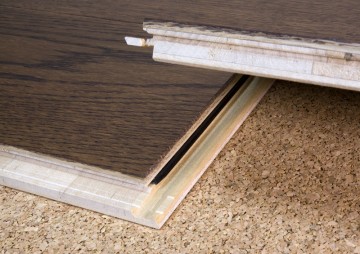 Wood continues to be one of the most preferred choices for floor coverings, and the number of wood-like flooring materials on the market is overwhelming. When it comes to real wood flooring, there are 2 main options: solid hardwood flooring and engineered hardwood flooring. It is often assumed that choosing between these two types of floors is a matter of personal preference, and in many case this may be true, but let’s compare solid and engineered hardwood flooring in order to better understand their pros and cons.
Wood continues to be one of the most preferred choices for floor coverings, and the number of wood-like flooring materials on the market is overwhelming. When it comes to real wood flooring, there are 2 main options: solid hardwood flooring and engineered hardwood flooring. It is often assumed that choosing between these two types of floors is a matter of personal preference, and in many case this may be true, but let’s compare solid and engineered hardwood flooring in order to better understand their pros and cons.
Solid Hardwood vs. Engineered Hardwood
1. Manufacturing Technique:
Solid hardwood is manufactured from a single piece of wood, the most common thickness of a solid hardwood plank is ¾”. The most widely used profile is tongue-and-groove (T&G).
Engineered hardwood consists of 2 or more layers. The top layer is wood veneer (industry norm is 2-4mm think top layer; Coswick uses only solid sawn 4mm wood lamellas for top layer). The lower layers consist either of several layers of plywood, HDF or solid wood (Coswick has 2 types of engineered flooring, with plywood and solid wood base layers). Multiple layers are bonded together under pressure. Profile may be either tongue-and-groove, or use a click-locking technology.
2. Properties:
Solid hardwood flooring is a 100% natural product that responds to air humidity variations. In order to avoid seasonal gapping from becoming noticeable and to reduce the amount of movement, relative indoor humidity level should be kept at 45-55% throughout the year.
Engineered hardwood has minimal movement and maintains superb dimensional stability through seasonal humidity fluctuations. In order to avoid seasonal gapping from becoming noticeable and to reduce the amount of movement, relative indoor humidity level should be kept at 40-65% throughout the year.
3. Dimensional stability:
Solid hardwood is a 100% natural product that responds to air humidity variations. During warm and humid summers, it is not unusual for wood to expand. During cold and dry winters, wood can contract. If room temperature and humidity levels are not kept in the optimum range, minor gapping or cupping may occur seasonally.
Because of the cross-layers of plywood and/or real wood used for middle and bottom layers, engineered hardwood flooring has enhanced internal balance and reduced possibility of twisting or warping. Seasonal movement is minimal, while dimensional stability through seasonal humidity and temperature fluctuations is superb. This is why engineered hardwood flooring is preferable over solid in interiors where fluctuations in humidity and temperature may be significant (cottages, basements etc).
4. Durability:
Both solid and engineered hardwood floors are very durable, but surface wear depends on the type of flooring finish, and not on whether your flooring is solid or engineered.
5. Price:
Some may assume that engineered hardwood is naturally cheaper than solid hardwood, but this is not always the case. Plank size, cost of lumber, as well as cost and quality of glues (used for adhering layers of engineered flooring) are often the cost determining factor here. Additionally, the cost of installation varies and depends on plank construction (click engineered floors, such CosLoc 5G for instance, can be installed using floating method, which significantly reduces installation costs).
6. Look and design:
One of the most prevalent beliefs about solid hardwood vs. engineered hardwood is that in order to get the look and feel of real wood, one must go with solid. Most engineered floors (and all of Coswick engineered flooring) use solid sawn wood lamellas, which means that the top layer is made of real wood, and have the look, texture and feel of solid wood floors. Both solid and engineered floors are available in the same range of finishes and stains, so there is virtually no difference in appearance.
Keep in mind that all prefinished engineered floors have a microbevel on all four sides, while site-finished solid hardwood does not.
7. Plank width:
Because solid hardwood is more sensitive to moisture and humidity fluctuations, the optimum plank width for solid wood flooring shouldn’t generally exceed 4 ¼”-5”, depending on the finish type.
In engineered hardwood, superb dimensional stability and resistance to humidity and temperature fluctuations allow for a much wider plank. Depending on construction type, Coswick engineered flooring is manufactured up to 7 ½” wide.
8. Installation:
Solid hardwood should be installed on or above grade, using nail down or staple down installation method.
Engineered hardwood can be installed in a wide range of interiors, on, below or above grade. Depending on construction type, nail down, glue down or floating methods of installation may be used. “Floating” is a simple DIY procedure that requires no special training and thus significantly reduces installation costs.
9. Eco- Friendliness:
100% wood, solid hardwood floors are a natural and eco-friendly flooring choice.
In engineered hardwood flooring, glues and materials used for middle and bottom layers define whether the floor is non-toxic and eco-friendly. Engineered floors, in which middle and bottom layers are made of solid wood, and are bonded by high quality non-toxic glues, are equal in their eco-friendly characteristics to solid hardwood.
Because the look and feel of solid vs engineered hardwood is virtually the same, the decision on which one to purchase and install should not be a matter personal preference, but rather a question of cost, climactic factors and other practical considerations.
Coswick manufactures solid and engineered hardwood floors in over 70 colors, styles and surface finishes. All Coswick floors are 100% formaldehyde-free and come under lifetime structural warranty. Order samples of solid and engineered Coswick floors and have them delivered to your door free of charge.



